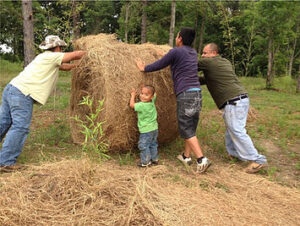Observations
One of the groves that I work with is Japanese Timber belonging to Robby Russell. It is over 25 years old. When Robby planted it, he dumped several piles of soil nearby. His idea was that when he dug plants to sell, he would fill the holes with dirt from the piles. Now, years later, the bamboo grows thick and plentiful on the piles of dirt. It grows noticeably less on the original grade.
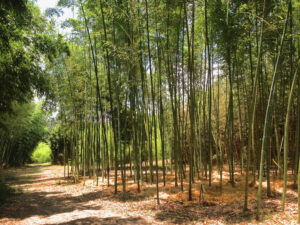 Take away: prepare your soil before planting by making it loose and friable and deep. Might even hill the future rows and leave the alleys flat. Be sure that the soil is rich in organic matter so that the soil is alive with bacteria, fungi, and assorted soil livestock. Allow no bare ground. Cover bare ground either with thick mulch or a cover crop consisting of multiple soil building plants.
Take away: prepare your soil before planting by making it loose and friable and deep. Might even hill the future rows and leave the alleys flat. Be sure that the soil is rich in organic matter so that the soil is alive with bacteria, fungi, and assorted soil livestock. Allow no bare ground. Cover bare ground either with thick mulch or a cover crop consisting of multiple soil building plants.
A second observation is that a rarely used dirt road edges the plantings of moso and Japanese Timber. These two giant bamboos do not cross this road. They do not cross compacted soil.
Take away: The bamboo will not spread into soil compacted by tractors and pickup trucks. Keep your trucks and tractors on designated roads. Do not drive where you want your bamboo to spread.
Land Preparation
Get rid of weeds. If the land that you prepare is wooded, you will have forest weeds – vines and seedling trees. If the land is an old meadow, you will have sun loving weeds, grasses, and rodents. Rodents eat the rhizomes of bamboo. They can devastate a new planting. Plants just fall over when roots and rhizomes are eaten. You need to till an old pasture to kill field mice and voles. Spend a year cultivating a diverse mixture of cover crops whether your site is forest, meadow or cropland in origin. Preparing the soil saves time because the bamboo will grow much faster and bigger in friable, organic, living soil. Bamboo planted in compacted, soil deadened by years of artificial fertilizers and mowing by tractors will stay stunted for years.
If you can break up the subsoil with a ripper plough, do that. The deeper the soil is aerated, the more air and moisture are available to the micro-organisms that support the bamboo. Incorporate organic matter and even biochar. Protect the soil with a cover crop of diverse plants as per conservation agriculture or spread mulch.
I did not prepare the soil at my bamboo research farm. Instead, we knocked over trees and burned them in piles the previous summer. We put in irrigation. In April we planted our pots of bamboo and rolled out round bales of old hay between the rows. Next season I had the power-line tree trimmers dump truckload after truckload of tree chips. Tree chips are perfect for mulching bamboo. My mulch controlled the weeds in the early years. I confess to using a backpack sprayer to control weeds. Because of my deep mulch, I have few weeds. About twice a summer I walk through the groves with my back pack sprayer and spot spray the seedlings with the two seed leafs still showing. I figure if I wait, the weeds will be larger and I will need more herbicide.
I will try to kill winter weeds with a propane torch. It has to be done after a rainstorm because of fire danger.
Keep Trees or Remove Them?
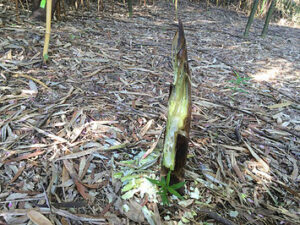
Trees look great near bamboo, BUT, squirrels live in trees. Squirrels kill the shoots that come up near the trees. They shred the culm leaf and eat the shoot inside. I had to remove trees that I had saved when clearing the land. It is harder to remove trees later after the bamboo has grown. The trees that remain, I am making less attractive to squirrels by covering some of the lower trunk with flashing. If squirrels can’t climb the tree because their claws can’t grab the flashing, will they go away? (I don’t have an answer yet as to whether my flashing inhibits squirrels. Besides they come in from the empty lot next door.)
Don’t plant in a location where the soil is cold in spring. One of my mature research groves in Fort Valley does not produce many shoots because it grows in a location where the soil warms slowly in spring. The grove is shaded by an ancient tree and grows on damp ground that slopes away from the sun. By the time the soil is warm, the shooting season for that bamboo has passed. (The grove flowered and died in 2019 and the ancient tree fell apart in 2022. )
Remove trees near the future groves, or at least most of them. At my farm I left trees on the north edge. My considerations were the aesthetics of trees and bamboo near each other and the knowledge that bamboo is a grass that evolved to coexist with trees. At my mature research groves which have ancient trees, I spray bamboo shoots along the tree line with a repellant called Critter BeGone or Critter Ridder. Got to keep the rodents from gnawing the shoots and killing them. Rain washes it off…
Irrigation
Most crops in Georgia are irrigated. Even tree crops like pecans and peaches are irrigated. While mature bamboo will grow without irrigation, it is more vigorous, tall and green with irrigation. Shoot production is better with irrigation. Dr. Koichiro Ueda noted that shoots appear after a rain. Seems like a good idea to irrigate the day before you are scheduled to harvest shoots.
Irrigation is essential for new plantings because roots and rhizomes have not yet reached out of the rootball and into the soil. Also irrigate the area outside the rootball to encourage the rhizomes to spread. Rhizomes grow towards moist, mulched, loose, organically rich soil. Most new plantings have drip irrigation because it is effective and cheap.
It is tricky to figure the best irrigation system. Drip lines are inexpensive but they get buried and lost in mulch. They will be cut by shovels during harvest of shoots. Raising them on wires above ground so they are visible makes them vulnerable to breaking when poles are harvested.
I have pop-up sprinkler heads designed for lawns. Stakes painted red mark their location. Over time, the heads (and valve boxes) get buried by mulch, then dirt, then rhizomes. Sometimes the heads need replacing because fine bamboo roots clog them. I plan to dig the heads and secure them on pipes about a foot above the mulch. Retrofitting is a lot of extra labor!
I’d prefer powerful sprinkler heads that throw the water far. I’d like them raised a couple of feet on sturdy posts. Big heads can throw water efficiently between the canes and under the leaf canopy, assuming you are properly thinning the groves. However, when the plants are small, their low branches would block tall heads.
Thin the bamboo every year starting in year four to allow the irrigation water to distribute, to increase yield, and to create conditions for straight uniform poles. If the grove is crowded with poles, new shoots will bend looking for light. Some of these light seeking poles are shaped like a giant “S”. Not useful.
Jaap Koppedrayer added irrigation to his mature Phyllostachys bambusoides grove in 2022. He under-grounded the main lines from the new well. His pipes in the grove are above ground. They are one inch in diameter and made from high grade, strong plastic for a long life. The advantage of pipes being above ground is that he can see them and avoid damaging them. To keep them visible, he can lift them as he sees falling leaves or mulch begin to hide them. Jaap’s sprinkler heads are hip high. They shoot 35′ and are head-to-head for perfect coverage. After the irrigation is done, “It is like there was a heavy rain.”
Mulch and cover crops
When you plant the bamboo, you will immediately need A LOT of mulch. The mulch suppresses weed seeds. Young bamboo cannot compete with weeds, grasses, vines, and young trees. Mulch protects the soil from overheating and drying out. It creates habitat for microorganisms that build healthy soil.
Mulch lightly around the root ball of the bamboo and heavily on the ground between the plants. Bamboo thrives with tree chips piled thickly between starts. People who don’t mulch heavily at planting, have to fight competing grasses within a few months.
First photo shows the crew rolling out the hay mulch.
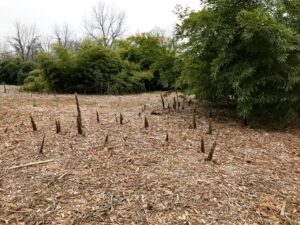
Second photo shows my moso in its fifth spring. It is shooting up in thick mulch well outside the edge of the grove. Have mulch; will spread!
Cover soil with mulch or cover crops.
Bamboo rhizomes will grow towards and into new piles of mulch. The following spring, a crowd of the largest canes in the planting area will emerge from the mulch piles.
A neighbor delivered round bales of hay near each of our 12 research groves in Year Four. I did not get the hay spread for months. Sure enough, there were masses of rhizomes under the hay bales. (And when we delayed spreading the hay, more (!!), shoots emerged from the top of the bales.)
To control grasses and weeds between rows do not rely on mowing with a tractor. A tractor compacts the ground. Rhizomes avoid compacted ground. Mowing with heavy equipment seriously delays the bamboo spreading and closing canopy.
I have seen moso’s growth outside of its original narrow row significantly slowed down by the combination of soil compacted by tractors and competition from weeds, tall grasses and brambles.
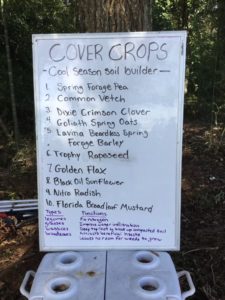 Either mulch between the rows of newly planted bamboo or plant a cover crop.
Either mulch between the rows of newly planted bamboo or plant a cover crop.
Tobaris Holmes, owner of Southbound Bamboo, grows moso bamboo in Unadilla, Georgia. He recommends planting moso plants in rows that are thickly mulched. He uses dump trailer loads of compost/mulch from the Georgia Agriculture Center. To save the cost of buying and spreading the mulch, he plants cover crops in the area outside the rows. Plant 10 or 12 varieties of plants as cover crops. Some will sequester nitrogen; some will have deep roots that open the soil; some will cover the bare soil quickly; some will provide habitat for insects and even nectar for humming birds.
Photo shows Tobaris’ list of cover plants.
Layout / Site plans
You want the bamboo to close canopy quickly. The shade from the closed canopy will reduce sun loving weeds and shade the canes so they will not be sunburned. Canes will stretch up to the sky instead of leaning sideways to the edge of the row.
The drawing below shows rows of bamboo twelve feet wide with 8 foot alleys. Alleys make it easier to harvest poles and shoots and easier to mulch and fertilize. Use light weight equipment in the alleys. We use either my dog team or a lawn tractor to pull the vehicle that carries the manure and/or mulch. Photo shows llama poop being spread in a young grove. My two dogs pull the poop wagon along the eight foot alley. They also pull the wagon with our buckets along the alleys when we harvest shoots. Notice how open the grove is. This openness (created by thinning the canes) makes harvesting shoots and spreading mulch easier.
In Years Six and Seven the canes will be tall enough to shade the alleys. You may be able to have denser stands of canes in the rows than if you had no alleys. Less thinning needed.
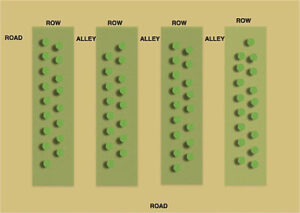
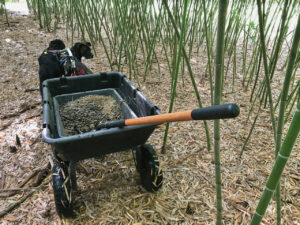
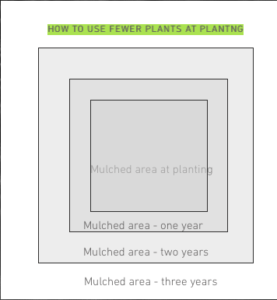 The second and third drawings show how to plant a large area with fewer plants. The inner area (the planted area) is entirely mulched. No tractor runs between the plants. Weeding is done by walking with a backpack sprayer and carefully spraying only the weeds, not the bamboo. If you can afford enough plants for the entire area, then mulch the entire area, but because bamboo spreads, there is no need to plant the entire area.
The second and third drawings show how to plant a large area with fewer plants. The inner area (the planted area) is entirely mulched. No tractor runs between the plants. Weeding is done by walking with a backpack sprayer and carefully spraying only the weeds, not the bamboo. If you can afford enough plants for the entire area, then mulch the entire area, but because bamboo spreads, there is no need to plant the entire area.
By the time you harvest your first shoots in Year Seven or more likely Year Eight, the bamboo will have spread to fill the unplanted outside area. This is assuming that you continually irrigate and mulch ahead of the bamboo where you want the bamboo to spread. Encourage the bamboo to spread by applying mulch one to several feet deep for it to spread into. Water lavishly both the bamboo and the mulch where you want it to spread.
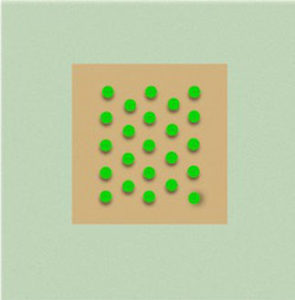 The outer, green area in the adjacent drawing can be mowed or hayed or planted to a diverse cover crop. It also can be grazed, assuming a movable fence system. It could be cropped. The compaction by mowing will be offset by the 10 or 15 foot wide layer of deep mulch surrounding the brown bamboo planting area. Each year, extend this mulched layer further.
The outer, green area in the adjacent drawing can be mowed or hayed or planted to a diverse cover crop. It also can be grazed, assuming a movable fence system. It could be cropped. The compaction by mowing will be offset by the 10 or 15 foot wide layer of deep mulch surrounding the brown bamboo planting area. Each year, extend this mulched layer further.
Delay the need to control spreading bamboo. Plant just the inner brown area. Your plants will spread into the green area.
Plan access routes for truck and tractor. You will need access for thinning, manuring and mulching, irrigating, weed control, and harvesting of shoots and poles. When the bamboo is full grown, these roadways will be shaded and the grass will die out. Every shoot that comes up in the roadway can be harvested. However, most timber bamboos will not cross a dirt road that is driven frequently. On Robby Russell’s dirt road which is rarely driven, the Houzeau crosses the road and invades the moso and henon. (Not a lot, but some.) The moso and henon never cross the road to the Houzeau.
Most bamboos do not spread into saturated soil. I have a winter pond in February and March some years. The water drowns the rhizomes of the nearby bamboos, Houzeau and Shanghai #3. These two bamboos can not spread into saturated soil even though it dries out in spring.
Bamboo will spread together in two years when planted 10 foot on center. Nine foot distances are fine also, especially if the plants are small (1 gallon in size). (Small plants will have trouble with bright sun and wind. Larger pots/plants are better.) The bamboo will spread outwards at the same time that it is closing rank inwards. Enable fast outward spread by deep mulch over friable soil, ample irrigation, and no weeds.
What Variety of Bamboo?
The choice of variety depends on your climate zone and what product(s) you wish to sell. For me, I am in USDA Plant Hardiness Zone 8. I sell bamboo shoots. I grow twelve varieties of bamboos with early, mid-, and late season shooting times. Twelve varieties gives me a harvest season of two months compared to two weeks for a single variety. If one bamboo has an off-year, others will be producing to fill the gap.
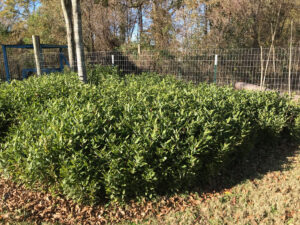 If I mainly wanted food for my livestock, I might choose mid-size varieties for ease of cutting and throwing into the pasture. I might choose dwarf varieties for machine harvesting when pastures dry up or for allowing livestock to graze when there is no grass. If I were to graze my dwarf bamboos, it would be only for a month or two before shooting. The dwarf bamboo does not grow continually from the base like pasture grass so does not tolerate sustained grazing.
If I mainly wanted food for my livestock, I might choose mid-size varieties for ease of cutting and throwing into the pasture. I might choose dwarf varieties for machine harvesting when pastures dry up or for allowing livestock to graze when there is no grass. If I were to graze my dwarf bamboos, it would be only for a month or two before shooting. The dwarf bamboo does not grow continually from the base like pasture grass so does not tolerate sustained grazing.
I planted dwarf bamboos along my pasture fence and let my three steers graze on the dwarfs that had spread inside the fence. The steers bent the wire fence trying to reach the delicious dwarf bamboo. In fact two of them stepped over the bent fence to eat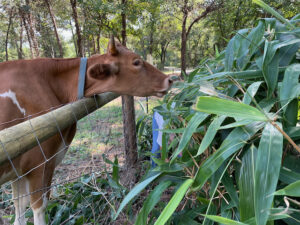 . I learned that planting dwarf bamboo next to a pasture is asking for fencing to be destroyed.
. I learned that planting dwarf bamboo next to a pasture is asking for fencing to be destroyed.
Photo shows yearling Guernsey steer reaching across fence to bite dwarf bamboo Indocalamus tessellatus. Notice the teeth marks on the truncated leaves. Luckily, this part of the fence is protected by wood posts so the fence is not bent. I mowed a path between fence and bamboo to protect the fence. And added an electric wire.
Where to source your plants
Find bamboo growers in your area on American Bamboo Society website. Visit their nurseries. Most bamboo nurseries will not have quantities suitable for planting acreage. Contract with them to grow the kind of bamboo that you want in the size and quantity that you want. During the contract year that they grow your bamboo, prepare your site. Bamboo grows quickly in good soil with good care. It languishes in poor soil. Small plants often can’t take the harsh sun and desiccating wind of being planted in a field. Large established potted plants grow faster than small ones. You will save time by preparing the site and buying established plants from nurseries that know and love bamboo.
Big starts that are well established grow faster than small ones. They survive the rigor of being planted in full sun and wind. They are more winter hardy than small plants grown from tissue culture under shade cloth. Be sure that the rootball of the plants that you buy are firm and have obvious rhizomes.
Some people find groves in their region and dig starts from these groves. (Hard work!) One of my friends hires a tree spade to move plants to a new field.
PLANTING Fields are usually planted by auguring the holes. These holes are deeper than the pot that the bamboo is in. Employees will plant bamboo too deep when holes are augured. Bamboo will die if dropped down into a hole. Soil placed on top of the rootball suffocates the rhizomes.
Before sending a crew to plant augured holes, backfill the augured hole so the hole is shallow. Set the bamboo rootball so its top is at the same height as the surrounding soil. And of course mulch the root ball lightly. Mulch the area outside the rootball heavily.
Fertilizer
Many farmers place slow release commercial fertilizer on top of the rootball at planting time. NPK follows the 3-1-2 rule for lawns. I consider the deep mulch of tree chips outside the rootball to act as a fertilizer for the bamboo because it invites a healthy soil biota. At my research farm in Hawkinsville, Georgia, I rolled out round bales of hay between plants. The bales were a year old so the farmer sold and delivered them for a reduced price. I figured that because bamboo is a grass it would thrive with a mulch of hay.
At my research plots of mature bamboo, I spread straw or hay most years. I also once a week pick up llama poop from a neighbor. I spread it on a new row each week.
We thin the mature groves and pile the poles alongside the dirt road. Once or twice a year, we rent a chipper that tows behind the truck. We chip the piled poles and the chipper blows the chips into the groves.
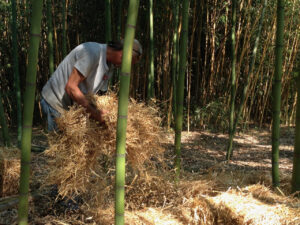 Below is my favorite quote for how to fertilize bamboo.
Below is my favorite quote for how to fertilize bamboo.
“The Cultivation of Bamboos in Japan“, by Sir Ernest Satow, K.C.M.G, The Asiatic Society of Japan, Tokio (sic) 1899 p.2
“The dead bodies of dogs, sheep, cats, rats and other animals, the skins, bones and hoofs of cattle and horses, are the best for this purpose. Decayed rice and wheat plants, rice and barley bran, and other vegetable matter, ashes, the contents of the dust-bin, rotten compost, stable litter, the dung and urine of men and horses, and lime where the soil is not sandy, may all be used.”
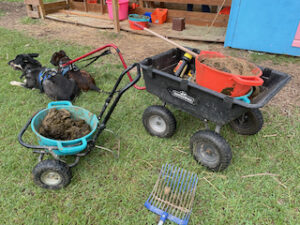 11/ 1/2021. I have had my Guernsey steers for 14 months. At first I piled manure outside the pasture and covered it with bamboo chips. Will be a fine compost soon. Now twice a day, I fill tubs with manure and my dogs pull it in my wagon into my groves. I spread it into the rows of bamboo leaving the alleys clean. And twice a day I cut bamboo poles and the dogs pull them to the steers to eat. Bamboo poles to steers. Steer manure to bamboo.
11/ 1/2021. I have had my Guernsey steers for 14 months. At first I piled manure outside the pasture and covered it with bamboo chips. Will be a fine compost soon. Now twice a day, I fill tubs with manure and my dogs pull it in my wagon into my groves. I spread it into the rows of bamboo leaving the alleys clean. And twice a day I cut bamboo poles and the dogs pull them to the steers to eat. Bamboo poles to steers. Steer manure to bamboo.
